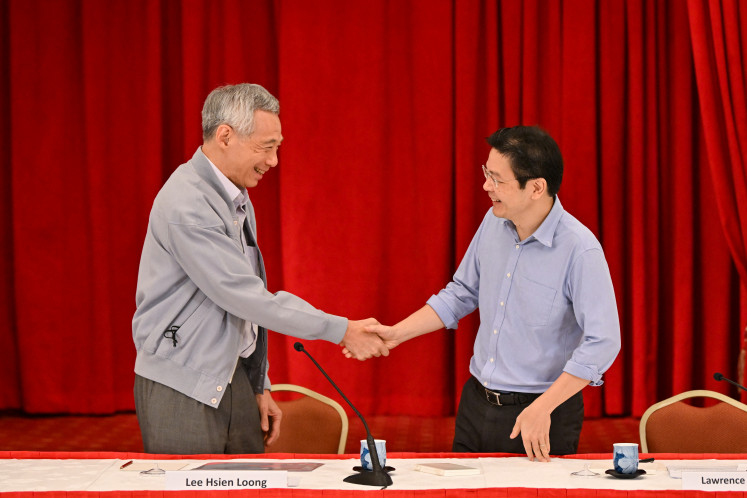Govt to launch new microloan program
The government plans to launch a new program this year aimed at increasing the disbursement of subsidized micro credit program (KUR) loans to micro, small and medium enterprises (MSME), after failing to meet its target last year
Change Size

T
span>The government plans to launch a new program this year aimed at increasing the disbursement of subsidized micro credit program (KUR) loans to micro, small and medium enterprises (MSME), after failing to meet its target last year.
Office of the Coordinating Economic Minister undersecretary for macroeconomy and finance Iskandar Simorangkir said that the government would further increase subsidized loan disbursements to MSMEs given their growing importance in the economy.
"We realize how important MSMEs are because our economy relies on them," Iskandar said in Jakarta on Tuesday. “The government, therefore, should support MSMEs through a financing program," he added.
As part of the effort to increase the disbursement of KUR loans to the productive sector, the government will use a financing scheme through a program called One Village One Product (OVOP).
The government will prioritize agriculture in the program's initial phase, but will later include the plantation, livestock and fisheries sectors.
The plan is part of a larger KUR program, which involves 44 lenders including both state-owned and private banks, to provide loans to small businesses that are considered unbankable in traditional markets but, nonetheless, have profit potential.
The contribution of the country’s nearly 63 million MSMEs to GDP is about 60 percent. MSMEs, which employ 97 percent of the total labor force in the country, contributed around 12 percent or Rp 298 trillion (US$21.76 billion) out of the Rp 2,260 trillion total exports in the same year.
"With a pro-MSME policy, we hope many micro businesses will be able to gradually upgrade themselves to become small, medium and then large-sized enterprises," Iskandar said. "The government is really confident about it."
The total KUR disbursement is estimated to rise from Rp 120 trillion in 2018 to Rp 139.5 trillion in 2019, the highest since 2008. The amount accounted for 99.65 percent of the government's Rp 140 trillion target last year.
The government is raising the ceiling of total KUR disbursement by about 36 percent to Rp 190 trillion this year from Rp 140 trillion last year. KUR disbursement is expected to further increase to Rp 335 trillion by 2024.
KUR loans channeled to MSMEs in productive sectors accounted for 51.1 percent of the total disbursement of Rp 139.5 trillion last year, rising from 47 percent in 2018. However, the KUR failed to meet its 60 percent target.
"We are creating a special KUR scheme because we know it was difficult [to meet the target]," Iskandar said. "This year we will launch the One Village One Product program. With this scheme, we are sure that the lenders will meet the disbursement target to the productive sectors."
In 2019, 48 percent of total KUR loans were channeled to trade, 26 percent to agriculture, forestry and hunting, 16 percent to services, 8 percent to the manufacturing, 2 percent to fisheries and 0.2 percent to construction.
According to Institute for Development of Economics and Finance (Indef) researcher Aviliani, the government should reduce the proportion of KUR disbursement to the trade sector because it was not able to add new economic output.
"Agriculture, fisheries, plantations and livestock are probably the only areas that need the government's subsidies," she told The Jakarta Post.
Aviliani said the government should determine if the targeted business sectors under the planned OVOP program had demand. "If loans are disbursed to a member of the cluster that does not have any demand, it may become a burden to its group," the Indef analyst said.
Between 2015 and 2019, non-performing loans under the KUR program were recorded at 1.1 percent.
According to Indonesian MSMEs Association (Akumindo) chairman Ikhsan Ingratubun, despite the cut in the interest rate, small enterprises in the productive sectors still cannot afford
KUR loans as most of them — except in those in the fashion, food and beverages sectors — have suffered business setbacks amid the country’s sluggish economic growth.
The government will lower the KUR annual interest rate from 7 percent to 6 percent, the lowest since 2008. The move came after the government had maintained a 7 percent annual rate since 2018. The rate is almost half of commercial rates.
This year, the government has allocated about Rp 13.9 trillion in subsidies for the KUR lending program, up from Rp 12.2 trillion in 2019. The subsidy is used to finance the difference between the KUR interest rate and the commercial loan rate.(dfr)









